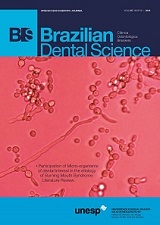Multidisciplinary approach for crown-root fracture treatment after trauma: case report
DOI:
https://doi.org/10.14295/bds.2013.v16i2.875Abstract
The development of an accurate diagnosis and appropriate treatment plan can be a complex task, especially in cases of dentoalveolar trauma. The authors present a case report of crown-root fracture caused by trauma and highlight the importance of a multidisciplinary approach for the treatment. An 18-year-old boy suffered a bicycle accident resulting in dental trauma. The right upper first molar showed a complicated crown-root fracture and the left lower second pre-molar showed an uncomplicated crown-root fracture. Endodontic treatment, controlled tooth extrusion, periodontal surgery for recovery of biological width and porcelain crown and onlay restoration were performed. Aesthetic and functional results were achieved. Two years follow-up has shown that the dental/onlay interface of the right upper first molar was stained and the onlay of the left lower second pre-molar was fractured. Therefore, the interface stained was repaired and a porcelain crown was made for the lower second pre-molar. The clinical case presented herein can conclude that a multidisciplinary treatment plan is extremely important for a proper resolution in cases of dentoalveolar trauma.
Downloads
Downloads
Additional Files
Published
How to Cite
Issue
Section
License
Brazilian Dental Science uses the Creative Commons (CC-BY 4.0) license, thus preserving the integrity of articles in an open access environment. The journal allows the author to retain publishing rights without restrictions.
=================




























